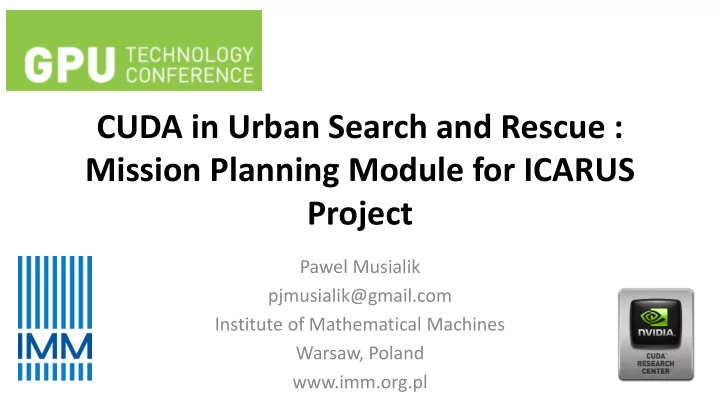

CUDA in Urban Search and Rescue : Mission Planning Module for ICARUS Project Pawel Musialik pjmusialik@gmail.com Institute of Mathematical Machines Warsaw, Poland www.imm.org.pl
ICARUS • I ntegrated Components for Assisted Rescue and Unmanned Search operations • Participants: • 24 partners • 10 countries • 2 end-users: • B-FAST • Portuguese Navy • 3 large industrials • NATO / NURC • Total Budget: 17.5 M €
ICARUS-IMM • Integration of Unmanned Search And Rescue tools in the C4I systems of the Human Search And Rescue forces • Development of a training and support system of the developed Unmanned Search And Rescue for the Human Search And Rescue teams
Mission Planners • Provide the unmanned platform operators with tools for fast and accurate initial mission planning • Lower the cognitive load of the operator during mission execution • The planner uses a semantic model as the basis for reasoning • Reasoning framework designed for CUDA
CUDA Hardware Supermicro RTG-RZ-124OI-NVK2: • 2 x 2.8GHz Xeon CPU (2 x 10 cores) • 256 GB RAM • 1.25 TB SSD • 2 x NVIDIA GRID K2 card Notebook with GeForce 660m as a personal terminal. GeForce Titan mission planning station.
Semantic Model “A semantic map for a mobile robot is a map that contains, in addition to spatial information about the environment, assignments of mapped features to entities of known classes. Further knowledge about these entities, independent of the map contents, is available for reasoning in some knowledge base with an associated reasoning engine. ”* Semantic model – a formalized description of the environment, based on provided ontology, which provides information about entities in the environment, their parameters and relations. *A. Nủ chter, J. Hertzberg ,”Towards semantic maps for mobile robots”, Robotics and Autonomous Systems Volume 56 Issue 11, November, 2008 , 915-926
Ontology QSTRR – Qualitative Spatio-Temporal Representation and Reasoning Basic sets: • Concepts • Relations • Rules Integration with HDM (Humanitarian Data Model)
Concepts Relations Rules Rules are the representation of general boundaries of the ontology. They are the basis for reasoning. Statement: Area that is safe to navigate does not have Region Connection Calculus 8 “Classes” of objects obstacles. that are in the Sequences of relations environment may be defined Rule: • Physical entities Quantitative description of Area:Safe is in relation DC • Abstract entities PO relation with physical concepts. • Parameters
Data Sources • GIS (Geographical Information System) • Ground 3D Point Clouds • Aerial 3D Point Clouds (from images)
Semantic Model
Preprocessing Steps: • Regular Grid Decomposition • Normal Vectors Computation • PCA/SVD algorithm • Calculation of shape descriptors from eigenvalues: E(e1,e2,e3) Linear=(e1-e2)/e1 Volumetric=e3/e1 Planar=(e1-e3)/e1 • Filtration Normal Vectors: 0.82s +Descriptors: 0.85s 300 000 points
Classification and Segmentation General Steps: 1. Ground Seed Search 2. Ground Filtration 3. Generation of normal vectors angles histogram 4. Initial Classification 5. Classification correction 6. Segmentation
Traversability by max slope: Increased Accuracy 10° 18° 25°
Aerial Point Clouds • Commercially available library developed by Dephos Software (CUDA-based) • Fast point classification to 5 object classes: • Ground • Building, • Vegetation (3 types) • Computation Time: 10 mln points, 1200x1050m: from 45s (low accuracy) to 120s (high accuracy) Geforce Titan
Basic planning problems Basic Reasoning – reasoning performed on a single concept instance. Cost Wave propagation algorithm* Area Information *”Qualitative Spatio-Temporal Representation and Return: Set S of area concepts in Reasoning for robotic applications” ,Janusz relation DC with robot concept Bedkowski, January 20, 2015
Complex planning problems Problems that require defining a full hypothesis space. Transforming complex problem to large number of independent simple queries Examples of Queries: • Global multi-Waypoint path optimization (traveling salesman problem) • Patrol path search • Building exploration path search • Network repeater position search • Optimal perception position search
General Planning Query
Network repeater Robot initial Found optimal Hypothesis space: robot concepts with position repeater position position and simulated signals strength. Rules: Is position reachable? Is signal one strong enough for the position? Is signal two strong enough for the position? Quantitative evaluation: Cost of path 0.4-4s
Path optimization Hill-Climbing algorithm
Conclusions • Raw data converted into a semantic model of the environment – use of CUDA allows per point approach without increasing computation time. • Mission planning framework dedicated for parallel computing • Converting complex problems into large sets of simple, low cost queries
Thank You for your attention Email: • pjmusialik@gmail.com ResearchGate: • www.researchgate.net/profile/Pawel_Musialik2 • www.researchgate.net/profile/Janusz_Bedkowski • www.researchgate.net/profile/Karol_Majek lider.zms.imm.org.pl The research leading to these results has received funding from the European Community's Seventh Framework Programme (FP7/2007-2013) under grant agreement n°285417. This work is done with the support of NCBiR (Polish Centre for Research and Development) project: ”Research of Mobile Spatial Assistance System” Nr: LIDER/036/659/L -4/12/NCBR/2013 Please complete the Presenter Evaluation sent to you by email or through the GTC Mobile App. Your feedback is important!
Recommend
More recommend